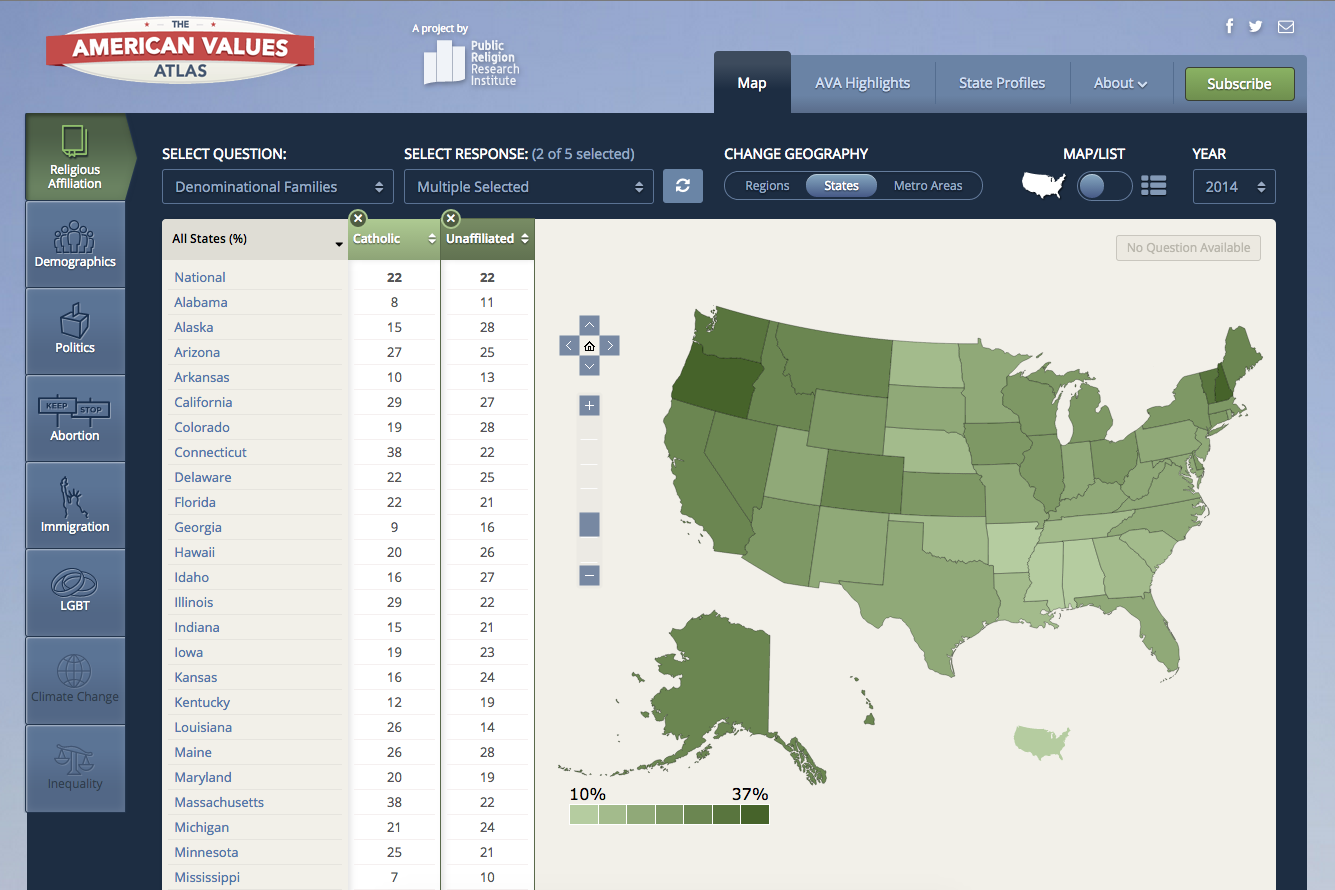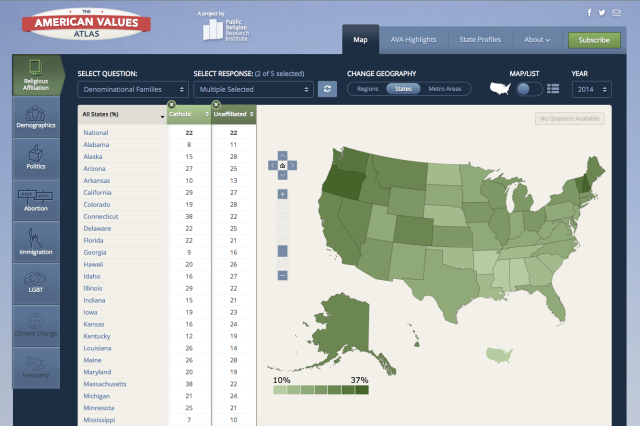10 Things the American Values Atlas Teaches Us About America’s Religious Landscape

Today we launch the American Values Atlas, a new, online tool that lets users see how Americans in each region, state, and major metro area feel about immigration, same-sex marriage, and abortion—in addition to seeing their religious, political, and demographic attributes.
Based on more than 50,000 interviews overall and 40,000 for select issues—immigration, same-sex marriage, and abortion—it may be difficult to know where to start!
But we have you covered: here are the top ten things the AVA tells us about America’s evolving religious landscape.
1. For the first time ever, America is not a majority Protestant nation. Only 47 percent of America identified as Protestant in 2014. At 81 percent, Mississippi is the most Protestant state in the union and Massachusetts is the least at 26 percent.
2. White Christians are the minority in 19 states. Hawaii and California have the smallest white Christian populations of any state—20 percent and 25 percent, respectively. White Christians also make up a modest proportion of the residents in other western states, including Oregon (43 percent), Washington (42 percent), Nevada (36 percent), and Arizona (38 percent).
3. More than 1-in-5 Americans are religiously unaffiliated. At 22 percent, the religiously unaffiliated rival other major religious groups in size, such as American Catholics, who make up 22 percent of the population. Young people are also three times more likely than seniors to be religiously unaffiliated—34 percent vs. 11 percent.
4. In fact, the religiously unaffiliated is the largest religious groups in 13 states, including Oregon (37 percent), New Hampshire (35 percent), Washington State (33 percent), and Vermont (32 percent).
5. The Northeast is still Catholic country. Over one-third (34 percent) of Northeast residents identify as Catholic—and 77 percent of the Catholics are white. Rhode Island is the most Catholic state in the union—more than 4-in-10 (44 percent) Rhode Islanders are Catholic.
6. Consistent with national trends, Evangelical Protestants are becoming less white. Today, roughly two-thirds (66 percent) of Protestants who identify as evangelical or born again are non-Hispanic whites. Black evangelical Protestants make up 21 percent of all evangelical Protestants in the U.S., while nearly 1-in-10 (9 percent) are Hispanic. Among evangelical Protestants under the age of 30, only 52 percent are non-Hispanic whites.
7. Hispanic Catholics make up an increasing proportion of Catholics. In the 2000s, the ratio of white to Hispanic Catholics was nearly 3-to-1; today, that ratio is 2-to-1. And that number is likely to rise: of young Catholics (age 18-29), nearly half (49 percent) are Hispanic, while 40 percent are white, non-Hispanic.
8. White evangelical Protestants are facing a generational divide on same-sex marriage, but not abortion. Nearly half (45 percent) of young white evangelical Protestants (age 18 to 29) favor allowing gay and lesbian couples to marry, while 49 percent are opposed. Among seniors (age 65+), only 19 percent favor allowing gay and lesbian couples to marry, while 74 percent are opposed. However, there are no generational differences in views about abortion. Thirty-one percent of young white evangelical Protestants say abortion should be legal in all or most cases, compared to 66 percent who say it should be illegal in all or most cases; thirty-two percent of white evangelical seniors say abortion should be legal in all or most cases, compared to 63 percent of white evangelical seniors who say abortion should be illegal in all or most cases.
9. Buddhists are the most likely to be single and Mormons are most likely to be married. Nearly half (48 percent) of Buddhists are single, while over two-thirds (69 percent) of Mormons are currently married, 17 points higher than the national average (52 percent).
10. Unitarians and white evangelical Protestants are aging, while Hindus and Muslims tend to be younger. Unitarians have an average age of 55, 7 years older than the national average (48 years). White evangelical Protestants and white Catholics also tend to be older than average, with 54 years old as adherents’ average age. Hindus and Muslims, on the other hand, have an average age of 36.
Explore more of the American Values Atlas here.


